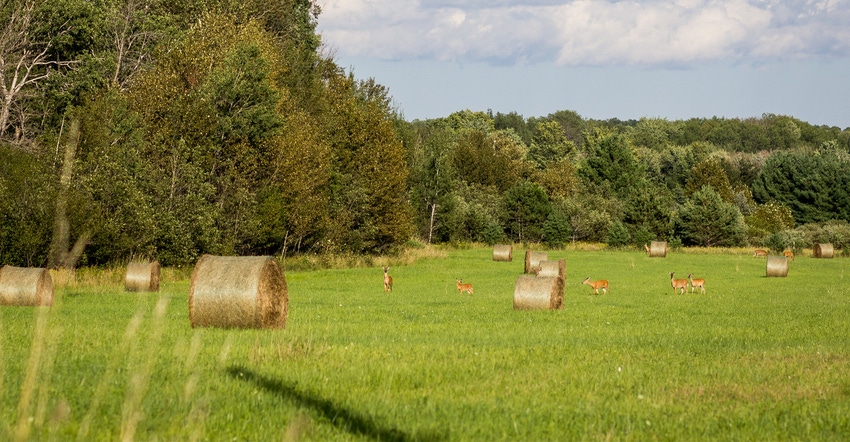
Michigan has been battling bovine tuberculosis in cattle for 20 years. Despite great effort and an enormous amount of resources directed at eradicating the disease, it’s still prevalent. Much too prevalent. USDA is considering moving Michigan a notch down in its accreditation after falling out of compliance with the current memorandum of understanding by exceeding the tolerated three TB-infected herds in a 12-month rolling calendar.
“We were in violation of the MOU in 2016, and it continued into 2017,” says James Averill, former Michigan Department of Agriculture and Rural Development state veterinarian, who was recently promoted to MDARD deputy director. “We’ve had five infected herds in the last 12 months.”
That spike in positive herds prompted a series of visits and conversations with USDA that have been ongoing since 2016.
In the past, USDA has provided some consideration for Michigan’s unique situation in that the disease has a natural reservoir in free-ranging, white-tailed deer. It also, for the first time, allowed a state to break into zones in 2004. Currently, the entire state of Michigan is accredited-free, except for the Modified Accredited Zone of Alcona, Alpena, Montmorency and Oscoda counties, where the disease is largely harbored.
In response to the MOU noncompliance, USDA in August 2017 provided two options:
• Reclassify Michigan’s Modified Accredited Zone (MAZ) to Accreditation Preparatory status for TB.
• Rescind Michigan’s current status and zones, and classify the entire state as Modified Accredited.
“Any of these actions would have major economic impact to the cattle industry in Michigan,” Averill says, noting the whole state, under MAZ, would have issues with FDA regarding the pasteurized milk ordinance. “The sale of milk would be in jeopardy. And we’d have to revert to whole-herd testing throughout the state, and if those four counties were dropped in status, it means that nothing leaves those four counties alive. It would certainly create a hardship,” he says.
Michigan, rather than face those consequences, submitted another option in late 2016. USDA has not returned a final decision, which Averill hopes is a good thing as they work to put more procedures in place to prevent deer contact with cattle and cattle feed.
The goal is to build on the Wildlife Risk Mitigation Project, which began in 2008 to help farmers adopt biosecurity practices.
MDARD, with the support of the DNR, recently approved a new zoning order, updating Michigan’s cattle regulations.
Two targeted efforts are being implemented by the new order. These efforts are focused on protecting cattle farms in the highest risk area with a newly designated area called the Enhanced Wildlife Biosecurity (EWB). This area is located at the core of MAZ and encompasses DMU 452. In this area, farmers will work with a team of experts to create customized wildlife biosecurity plans based on identified risk factors on their farms.
The EWB includes 130 producers. “A team will sit down with each producer and talk about risks and biosecurity practices,” Averill says. “We will walk their operation and identify what we could be doing to further protect their investments.”
Those plans are due to be done by June 1, and high-risk infrastructure changes completed by Dec. 31. More than 50 herd owners have already volunteered to work with a team. The Michigan Legislature earmarked $980,000 to cost-share with producers, with the state picking up 75% of the cost.
Averill says that may include fence around free storage and three-dimensional fencing for pastures. “That includes a common 4- to 5-foot-tall fence and then another fence 3 or so feet away that is 2 to 3 feet tall,” he says. It gives an optical illusion to deer they can’t jump over; they can’t clear both of them, and there’s not enough space in between.”
Also under the EWB, USDA Wildlife Services will conduct several visits to monitor properties and remove deer present on farms. “Some deer on farms are extremely bold, even going so far as to slip into unclosed gates and learning a farmer’s habits to access high-quality feeds, like silage,” Averill says. “The only viable way to protect a farm from these resident deer is to remove them and then implement strategies to discourage future deer from taking on this habit.”
To sell cattle outside of slaughter channels, cattle producers in the EWB area will now be required to participate in both efforts.
DNR has other tools available as well, including hunter access programs and enhancements to habitat to hold deer in natural areas vs. the farm. “There will also be boots on the ground to chat with the hunting community,” Averill says. “It’s import to stress the impacts of TB on the state of Michigan and to address it,” he adds.
Two out-of-season hunts in northeast Michigan were already held in January.
More than 13,000 cattle producers in Michigan maintain over 1.1 million cattle each year. Averill hopes these measures will keep the industry healthy and avert a downgrade in TB status. “Downgrading our status doesn’t get us anywhere; it doesn’t address the disease with the wildlife reservoir,” he says.
In short, Averill says the consensus is that the industry, both in the MAZ and statewide, cannot risk another spike in TB positive herds like the one that occurred in 2016. “Maintaining a viable cattle industry will require increased vigilance and participation of cattle producers in the EWB area. And cattle producers and hunters across the state need to be aware of the sacrifice these farmers are making,” he says.
About the Author(s)
You May Also Like






